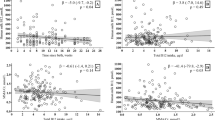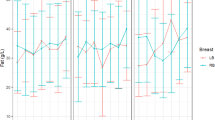Abstract
Background
There is scant information on the breastmilk vitamin A (BMVA) concentration of lactating women in developing countries, partly due to lack of methods applicable in-field.
Objective
To assess BMVA concentrations of samples collected from lactating women of children aged 6–23 months, in Mecha district, Ethiopia.
Subjects/methods
Data on socio-demographic and anthropometric characteristics were collected from randomly selected lactating women (n = 104). Breast milk samples were collected and vitamin A concentrations were analyzed using HPLC and iCheck FLUORO then the two measurements were compared.
Results
The prevalence of underweight (BMI < 18.5 kg/m2) among lactating women was 17%. Seventy six percent of the BMVA values were <1.05 µmol/l and 81% were <8 µg/g fat. The mean BMVA concentration accounted to 41% of the estimated average value for mothers in developing countries. The BMVA values from HPLC and iCheck were correlated (r = 0.59, p = < 0.001), but it was not strong.
Conclusions
The result indicates the low vitamin A status of the lactating women and their children. It further indicates that intake assessments should not use average BMVA composition. The possibility of using iCheck for monitoring interventions designed to improve vitamin A status of lactating women with low BMVA requires further investigation.
This is a preview of subscription content, access via your institution
Access options
Subscribe to this journal
Receive 12 print issues and online access
$259.00 per year
only $21.58 per issue
Buy this article
- Purchase on Springer Link
- Instant access to full article PDF
Prices may be subject to local taxes which are calculated during checkout


Similar content being viewed by others
References
Stevens GA, Bennett JE, Hennocq Q, Lu Y, De-Regil LM, Rogers L, et al. 2015. Trends and mortality eff ects of vitamin A deficiency in children in 138 low-income and middle-income countries between 1991 and 2013: a pooled analysis of population-based survey. Lancet Glob Health. 2015;3:e528–36.
Baye K, Guyot J, Lcard-Verniere C, Mouquet-Rivier C. Nutrient intakes from complementary foods consumed by young children (aged 12-23 months) from North Wollo, northern Ethiopia: the need for agro-ecologically adapted interventions. Public Health Nutr. 2013;16:1741–50.
Ross JS, Harvey PWJ. Contribution of breastfeeding to vitamin A nutrition of infants: a simulation model. Bull World Health Organ. 2003;81:80–6.
Ross AC, Pasatiempo AMG, Green MH. Chylomicron migration, lipolysis, and vitamin A uptake in the lactation rat mammary gland: implications for milk retinol content. Exp Biol Med. 2004;229:46–55.
Haskell MJ, Brown KH. Maternal vitamin A nutriture and the vitamin A content of human milk. J Mammary Gland Biol Neoplasia. 1999;4:243–57.
Stoltzfus RJ, Underwood BA. Breast-milk vitamin A as an indicator of the vitamin A status of women and infants. Bull World Health Organ. 1995;73:703–11.
Anderson VP, Cornwall J, Jack S, Gibson RS. Intakes from non-breastmilk foods for stunted toddlers living in poor urban villages of Phnom Penh, Cambodia, are inadequate. Matern Child Nutr. 2008;4:146–59.
Lander R, Enkhjargal TS, Batjargal J, Bolormaa N, Enkhmyagmar D, Tserendolgor, et al. Poor dietary quality of complementary foods is associated with multiple micronutrient deficiencies during early childhood in Mongolia. Public Health Nutr. 2010;13:1304–13.
Laillou A, Renaud C, Berger J, Moench-Pfanner R, Fontan L, Avallone S. Assessment of a portable device to quantify vitamin A in fortified foods (flour, sugar, and milk) for quality control. Food Nutr Bull. 2014;35:449–57.
Schweigert FJ, Frey SK, Mothes R, Dary O, Juarez P, Lascano VA. A new test kit’s potential for the rapid analysis of vitamin A in human and cow milk. Sight Life Mag. 2011;25:18–22.
Engle-Stone R, Haskell MJ, Nankap M, Ndjebayi AO, Brown KH. Breast milk retinol and plasma retinol-binding protein concentrations provide similar estimates of vitamin A deficiency prevalence and identify similar risk groups among women in Cameroon but breast milk retinol underestimates the prevalence of deficiency. J Nutr. 2014;144:209–17.
Engle-Stone R, Haskell MJ, La Frano MR, Ndjebayi AO, Nankap M, Brown KH. Comparison of breast milk vitamin A concentration measured in fresh milk by a rapid field assay (the iCheck FLUORO) with standard measurement of stored milk by HPLC. Eur J Clin Nutr. 2014;68:938–40.
WHO. Training course on child growth assessment. Geneva, Switzerland: World Health Organization; 2008.
WHO. Physical status: the use and interpretation of anthropometry. Geneva, Switzerland: World Health Organization; 1995.
Feeley RM, Eitenmiller RR, Jones JB, Barnhart H. Calcium, phosphorus, and magnesium contents of human milk during early lactation. Pediatr Gastroenterol Nutr. 1983;2:262–7.
Kent JC, Mitoulas LR, Cregan MD, Ramsay DT, Doherty DA, Hartmann PE. Volume and frequency of breastfeedings and fat content of breast milk throughout the day. Pediatrics. 2006;117:e387–95.
Lucas A, Gibbs JA, Lyster RL, Baum JD. Creamatocrit: simple clinical technique for estimating fat concentration and energy value of human milk. Br Med J. 1978;1:1018–20.
WHO. Complementary feeding of young children in developing countries: a review of current scientific knowledge. Geneva, Switzerland: World Health Organization; 1998.
WHO. Indictors for assessing vitamin A eficiency and their application in monitoring and evaluating intervention programmes. Geneva, Switzerland: World Health Organization; 1996.
Chung MY. Factors affecting human milk composition. Pediatr & Neonatol. 2014;55:421–2.
Zerfu TA, Umeta M, Baye K. Dietary habits, food taboos, and perceptions towards weight gain during pregnancy in Arsi, rural central Ethiopia : a qualitative cross-sectional study. J Health Popul Nutr. 2016;35:1–7.
Van Stuijvenberg ME, Schoeman SE, Nel J, Lombard CJ, Dhansay MA. Serum retinol in post-partum mothers and newborns from an impoverished South African community where liver is frequently eaten and vitamin A deficiency is absent. Maternal Child Nutr. 2015; 1–10.
Turner T, Burri BJ, Jamil KM, Jamil. M. The effects of daily consumption of b-cryptoxanthin – rich tangerines and b-carotene – rich sweet potatoes on vitamin A and carotenoid concentrations in plasma and breast milk of Bangladeshi women with low vitamin A status in a randomized controlled tri. Am J Clin Nutr. 2013;98:1200–8.
Jus’at L, Jahari AB, Htet MK, Tilden RL. Vitamin A-fortified cooking oil reduces vitamin A deficiency in infants, young children and women: results from a programme evaluation in Indonesia. Public Health Nutri. 2015;18:2511–22.
Oliveira J, Allert R, East C. Vitamin A supplementation for postpartum women (review). Cochrane Database Syst Rev. 2016; CD005944.
Klevor MK, Haskell MJ, Lartey A, Adu-Afarwuah S, Zeilani M, Dewey KG. Lipid-based nutrient supplements providing approximately the recommended daily intake of vitamin A do not increase breast milk retinol concentrations among Ghanaian women. J Nutr. 2016;146:335–42.
Palmer AC, Chileshe J, Hall AG, Barffour MA, Molobeka N, West KP Jr, et al. Short-term daily consumption of provitamin A carotenoid – biofortified maize has limited impact on breast milk retinol concentrations in Zambian women enrolled in a randomized controlled feeding trial 1 – 3. J Infect Dis. 2016;146:1783–92.
Tanumihardjo SA, Mokhtar N, Haskell MJ, Brown KH. Assessing the safety of vitamin A delivered through large-scale intervention programs : workshop report on setting the Research Agenda. Food Nutr Bull. 2016;37:63–74.
FAO & WHO. Vitamin and mineral requirements in human nutrition. 2nd ed. Geneva, Switzerland: World Health Organization; 1998.
Butte N, Lopez-Alaracon M, Garza C, 2002. Nutrient adequacy of exclusive breastfeeding for the term infant during the first six months of life. Geneva: WHO; 2002.
WHO Multicentre Growth Reference Study Group. WHO Child Growth Standards based on length/height, weight and age. Acta Paediatr Suppl. 2006; 450, 76–85.
Funding
This study was funded by the German Academic Exchange service (DAAD)
Author contributions
All authors were involved in developing the study design. ZA and KB looked for funding. ZA coordinated and supervised the fieldwork. ZA and KB analyzed and interpreted the data. ZA wrote the first draft of the manuscript. All the authors contributed to manuscript preparation.
Author information
Authors and Affiliations
Corresponding authors
Ethics declarations
Conflict of interest
FS is the founder and share-holder of BioAnalyt, iCheckFluoro producing company. The remaining authors declare that they have no conflict of interest.
Ethics
Ethical approval was obtained from the Human Ethics Committees of the College of Natural Sciences (Addis Ababa University) and National Research Ethics Committees, Ethiopia. The purpose and methods of the study had been explained to the women. Verbal informed consent was obtained in the presence of local health community workers. The questionnaires were first prepared in English, then were back-translated to the local language (Amharic) to ensure the accuracy of the translation.
Rights and permissions
About this article
Cite this article
Abebe, Z., Haki, G.D., Schweigert, F.J. et al. Low breastmilk vitamin A concentration is prevalent in rural Ethiopia. Eur J Clin Nutr 73, 1110–1116 (2019). https://doi.org/10.1038/s41430-018-0334-4
Received:
Revised:
Accepted:
Published:
Issue Date:
DOI: https://doi.org/10.1038/s41430-018-0334-4
This article is cited by
-
Geographic and socio-demographic determinants of plasma retinol concentrations in Chinese pregnant and lactating women
European Journal of Nutrition (2022)



